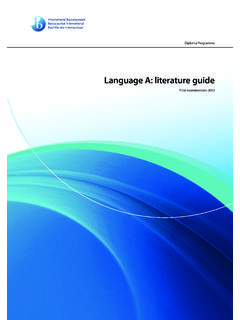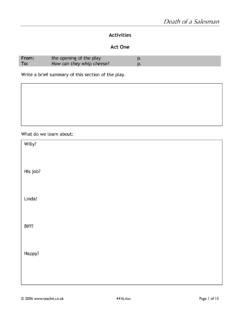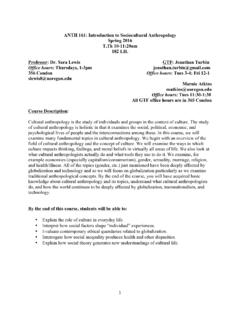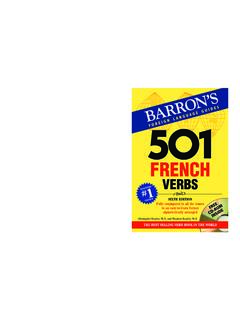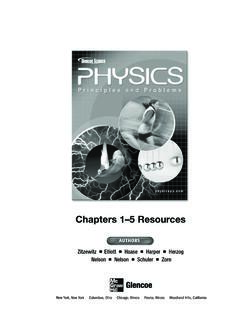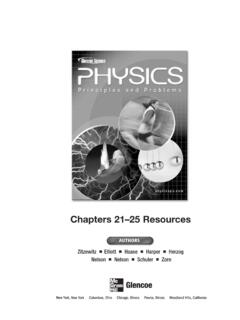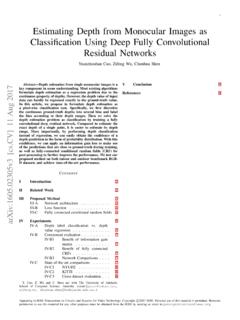Transcription of Maths Investigation Ideas for A-level, IB and Gifted GCSE ...
1 1 Maths Investigation Ideas for A-level, IB and Gifted GCSE Students All this content taken from my site at you might find it easier to follow hyperlinks from there. I thought I d put a selection of the posts I ve made over the past year into a word document these are all related to Maths investigations or enrichment Ideas . Some are suitable for top set students across the year groups, others may only be suitable for sixth form students. However, whatever level you teach there ll definitely be something of use! 2 Index: Page 3 - 7 More than 100 Ideas for Investigation /enrichment topics for sixth form Maths students Pages 8 10 Secondary data resources and suggestions for investigations Ideas .
2 Pages 11 - 22 Statistics Topics Premier League Finances, The Mathematics of Bluffing, Does Sacking a Manager Affect Results, Maths in Court, Digit Ratios and Maths Ability, The Birthday Problem Pages 23 - 40 Geometry Topics Circular inversion, Graphically understanding Complex Roots, Visualising Algebra, The Riemann Sphere, Imagining the 4th Dimension Pages 41 49 Modelling Topics Modelling Infections, Real Life Differential Equations, Black Swan Events Pages 50 71 Pure Maths and Calculus Fermat s Theorem on Squares, Euler and e, Divisibility Tests, Chinese Remainder Theorem, Proof and Paradox, War Maths , The Goldbach Conjecture, The Riemann Hypothesis, Twin Primes, Time Travel Pages 72-93 Games and Codes Tic Tac Toe Game Theory and Evolution Knight s Tour Maths and Music Synathesia Benford s Law to catch fraudsters The Game of Life RSA code and the internet, NASA and codes to the stars 3 Maths Exploration Topics: 100+ Ideas for investigations.
3 Algebra and number 1) Modular arithmetic - This technique is used throughout Number Theory. For example, Mod 3 means the remainder when dividing by 3. 2) Goldbach s conjecture: "Every even number greater than 2 can be expressed as the sum of two primes." One of the great unsolved problems in mathematics. 3) Probabilistic number theory 4) Applications of complex numbers: The stunning graphics of Mandelbrot and Julia Sets are generated by complex numbers. 5) Diophantine equations: These are polynomials which have integer solutions. Fermat's Last Theorem is one of the most famous such equations. 6) Continued fractions: These are fractions which continue to infinity. The great Indian mathematician Ramanujan discovered some amazing examples of these.
4 7) Patterns in Pascal s triangle: There are a large number of patterns to discover - including the Fibonacci sequence. 8) Finding prime numbers: The search for prime numbers and the twin prime conjecture are some of the most important problems in mathematics. There is a $1 million prize for solving the Riemann Hypothesis and $250,000 available for anyone who discovers a new, really big prime number. 9) Random numbers 10) Pythagorean triples: A great introduction into number theory - investigating the solutions of Pythagoras' Theorem which are integers (eg. 3,4,5 triangle). 11) Mersenne primes: These are primes that can be written as 2^n -1. 12) Magic squares and cubes: Investigate magic tricks that use mathematics.
5 Why do magic squares work? 13) Loci and complex numbers 14) Egyptian fractions: Egyptian fractions can only have a numerator of 1 - which leads to some interesting patterns. 2/3 could be written as 1/6 + 1/2. Can all fractions with a numerator of 2 be written as 2 Egyptian fractions? 15) Complex numbers and transformations 16) Euler s identity: An equation that has been voted the most beautiful equation of all time, Euler's identity links together 5 of the most important numbers in mathematics. 17) Chinese remainder theorem. This is a puzzle that was posed over 1500 years ago by a Chinese mathematician. It involves understanding the modulo operation. 18) Fermat s last theorem: A problem that puzzled mathematicians for centuries - and one that has only recently been solved.
6 19) Natural logarithms of complex numbers 20) Twin primes problem: The question as to whether there are patterns in the primes has fascinated mathematicians for centuries. The twin prime conjecture states that there are infinitely many consecutive primes ( eg. 5 and 7 are consecutive primes). There has been a recent breakthrough in this problem. 21) Hypercomplex numbers 4 22) Diophantine application: Cole numbers 23) Odd perfect numbers: Perfect numbers are the sum of their factors (apart from the last factor). ie 6 is a perfect number because 1 + 2 + 3 = 6. 24) Euclidean algorithm for GCF 25) Palindrome numbers: Palindrome numbers are the same backwards as forwards. 26) Fermat s little theorem: If p is a prime number then a^p - a is a multiple of p.
7 27) Prime number sieves 28) Recurrence expressions for phi (golden ratio): Phi appears with remarkable consistency in nature and appears to shape our understanding of beauty and symmetry. 29) The Riemann Hypothesis - one of the greatest unsolved problems in mathematics - worth $1million to anyone who solves it (not for the faint hearted!) 30) Time travel to the future: Investigate how traveling close to the speed of light allows people to travel "forward" in time relative to someone on Earth. Why does the twin paradox work? 31) Graham's Number - a number so big that thinking about it could literally collapse your brain into a black hole. 32) RSA code - the most important code in the world? How all our digital communications are kept safe through the properties of primes.
8 33) The Chinese Remainder Theorem: This is a method developed by a Chinese mathematician Sun Zi over 1500 years ago to solve a numerical puzzle. An interesting insight into the mathematical field of Number Theory. 34) Cesaro Summation: Does 1 1 + 1 1 .. = 1/2?. A post which looks at the Maths behind this particularly troublesome series. 35) Fermat's Theorem on the sum of 2 squares - An example of how to use mathematical proof to solve problems in number theory. 36) Can we prove that 1 + 2 + 3 + 4 .. = -1/12 ? How strange things happen when we start to manipulate divergent series. 37) Mathematical proof and paradox - a good opportunity to explore some methods of proof and to show how logical errors occur.
9 Geometry 1) Non-Euclidean geometries: This allows us to "break" the rules of conventional geometry - for example, angles in a triangle no longer add up to 180 degrees. 2) Hexaflexagons: These are origami style shapes that through folding can reveal extra faces. 3) Minimal surfaces and soap bubbles: Soap bubbles assume the minimum possible surface area to contain a given volume. 4) Tesseract a 4D cube: How we can use Maths to imagine higher dimensions. 5) Stacking cannon balls: An Investigation into the patterns formed from stacking canon balls in different ways. 6) Mandelbrot set and fractal shapes: Explore the world of infinitely generated pictures and fractional dimensions. 7) Sierpinksi triangle: a fractal design that continues forever.
10 8) Squaring the circle: This is a puzzle from ancient times - which was to find out whether a square could be created that had the same area as a given circle. It is now used as a saying to represent something impossible. 9) Polyominoes: These are shapes made from squares. The challenge is to see how many different shapes can be made with a given number of squares - and how can they fit together? 10) Tangrams: Investigate how many different ways different size shapes can be fitted together. 11) understanding the fourth dimension: How we can use mathematics to imagine (and test for) extra dimensions. 12) The Riemann Sphere - an exploration of some non-Euclidean geometry. Straight lines are not straight, parallel lines meet and angles in a triangle don't add up to 180 degrees.

